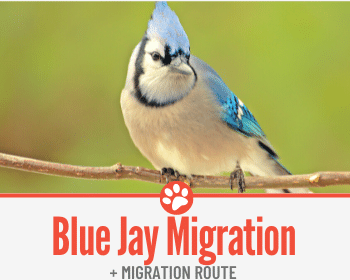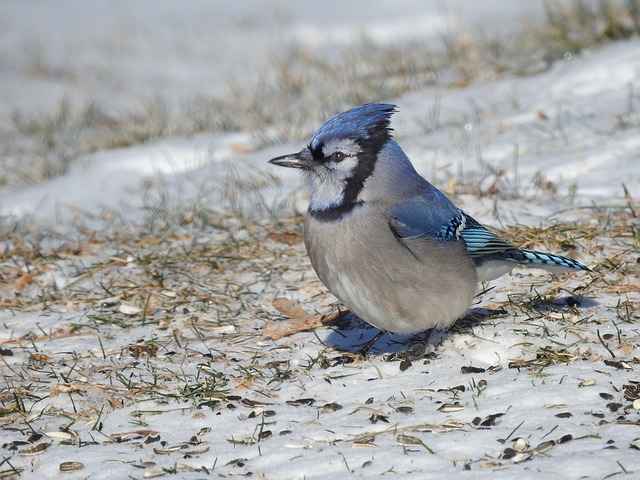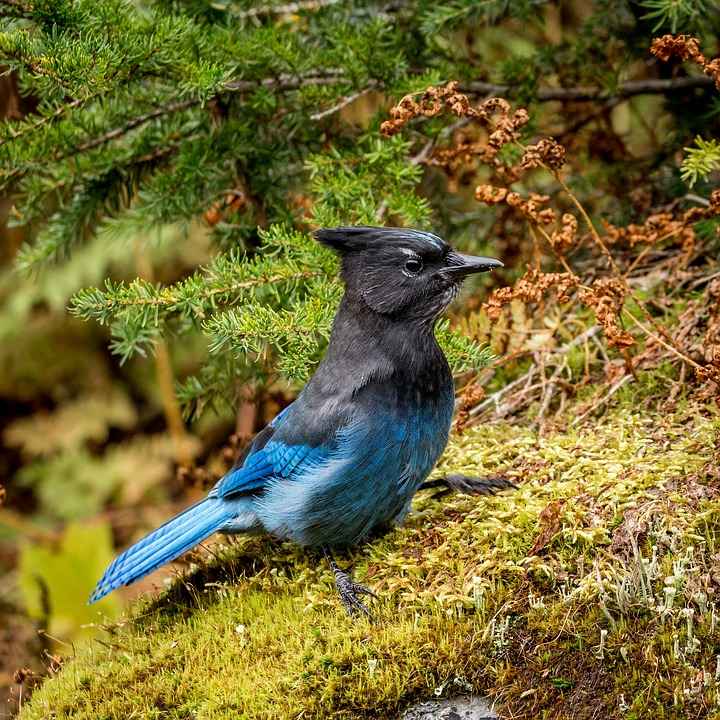 Some birds are thought to migrate twice a year while others are believed to migrate just once.
Some birds are thought to migrate twice a year while others are believed to migrate just once.
Yet there are some that people are not sure about; maybe they migrate, maybe they don’t. Maybe just some of them migrate.
Blue Jays belong to the latter group as they are seen in different parts of US and Canada at the same time and hence ornithologists find deep interest in Blue Jays and their Migration Routes.
Do Blue Jays migrate?
Blue Jays are one of those unpredictable birds, Blue Jays do Migrate, but their migratory patterns are not well understood. Observers believe that some of them migrate while others remain in their nesting area.
For instance, a research by Stewart, who analyzed more than eight thousand recaptured Blue Jay birds in the USA, was unable to find a defining factor that could determine which breed of the Blue Jays migrate south and which of them would stay in their nesting area in central and southern Canada and the north of USA.
As is agreed upon by a number of studies and as has been shared by some independent observers, it can be safely said that the migration pattern of the Blue Jay is not very clear.
Some ornithologists assert on the theory that young jays predominantly migrate in hopes of having better luck finding food during the winter months, but others claim that there is no difference as older and younger Jays migrate at equal rates.
Blue Jay Migration
Blue Jays are migratory birds with unexplained migratory patterns. There are certain zones in Canada and the USA where the Blue Jays are seen permanently, throughout the year.
They live and nest across eastern North America and if we go towards west, they can be found as far as the Rocky Mountains. Similarly going north they can be found in central Canada.
Blue Jays have over time expanded their range into the Pacific Northwest, and in some winters, they can go as far as eastern New Mexico and eastern Wyoming.
Many people in the Blue Jay range in Canada and the USA are used to having Blue Jays being in their yards and at their feeders year-round leading them to believe that Blue Jays don’t actually migrate.
The reality is that the Blue Jay has a rather spectacular migration which researchers as well as hundreds of common people witness every year. In the fall Blue Jays migrate south but the numbers would change every time; in some years people witness big southward flights, with thousands of birds flying together, however, they are not believed to go south of the United States.
When the northern birds start flying towards south as winters approach, they become part of huge flocks that could go up to 250 birds and embark on the long journey. Interestingly, this migration of the Blue Jays is a bit of an unknown to scientists.
Sometimes whole family of Blue Jays is thought to migrate while at other times it is an individual bird that may migrate one year but choose not to dear the next year. The factors that determine as whether it is an individual young Blue Jay or the whole family that decides to migrate is not known.
The most spectacular part of their migration happens along the Great Lakes and the Atlantic coast where large flocks of several Blue Jays migrate. Unlike many songbirds, Blue Jays are mostly diurnal (day time) migrants so this migration is highly viable to birders. Every year people witness flocks of thousands of Blue Jays migrating along the shore of Lake Erie during the spring migration.
Similarly, the number of Blue Jays migrating in the fall peaks during September and early October when flocks of hundreds of the birds could be seen on the move.
One close observer of the Blue Jay in North of Toronto, Canada remarks saying he has Blue Jays around whole year. Some of them do migrate. According to him spring is the most exciting season for sure as lots of varieties of birds arrive in the north.
Another observer on Lake Ontario says she looks forward to the Blue Jay migration every year and she says Blue Jays are silent during their migration along the lake.
Yet another person living in Avon Lake on Lake Erie says that it has been an incredible sight over the years to see flocks of hundreds at time of Blue Jays flying overhead. Once, he remarks, he thought there was a Blue Jay convention!
Blue Jays are a common scene in much of eastern as well as central North America, and now they seem to gradually extend their reach to Northwest America as well. Blue Jays are social birds and are mostly in pairs as well as in family groups and small flocks.
Blue Jay migration route
Blue Jays, starting from the north of central Canada, keep migrating towards south in autumn. In summer they take the same route back to the north of central Canada. A lot of studies, books and social media posts have described observations of the southward flight of Blue Jays in autumn.
Some of them have presented evidence of a northward migration of this species in spring. There are a lot more statements from individual observers regarding the spring migration.
Some of the individual Blue Jays migrate towards south one year, the next year they would stay north for winter, and then migrate again towards south the following year. This has not yet be determined by anyone as to why they follow the migration patter that they do.
The migration route is never free of danger. Thousands of Blue Jays get killed during their migration. The reasons vary, however, the most evident one being the big cities and the skyscrapers in those cities.
Especially during night these birds come face to face with glittering lights and huge buildings, befuddled and crashing into windows, trying to go across and finally falling to the ground exhausted. Thousands of birds have been seen starving to death either because of crashing into buildings or getting lost in a maze of the huge buildings and starving to death.
Do Blue Jays migrate South?
Migration of Blue Jays towards south happens every year. However, not all Blue Jays are believed to migrate every year. Some individual Blue Jays migrate towards south but that does not happen every year, during some autumns they choose not to fly south.
Similarly, some Blue Jays fly south for one year, they stay north during the winter of the following year, and then they migrate again towards south the next year.
It has not been figured out by anyone as to why they migrate when they do. It would be interesting for you to know that some of the Blue Jays that you see in your feeders during the winter could be different to those you see in your yard during the summer.
From mid-September to mid-October every year, some bird watching groups and individuals living in the major migration routes including the Atlantic Coast and the Great Lakes report several flocks of Blue Jays flying towards south. Thousands of flying blue birds together make spectacular scenes.
Do Blue Jays migrate from Canada?
Blue Jays migrate from Canada and do so in amazing numbers, as some observers would remark saying it looks like a river of blue is passing. With thousands of Blue Jays flying south, one would think that the cold parts of Canada would have no Blue Jays left during the winter.
However, that’s not totally true. Many Blue Jays do stay close to their nesting area for the entire winter, even in the far northern parts of Canada which including parts of the USA is the breeding range of Blue Jays.

Do Blue Jays migrate for the winter
Not all but some Blue Jays migrate towards south every year while others remain on their nesting grounds during the winter. Individual Blue Jays fly towards south in some years, however, they opt to remain on their nesting areas throughout other years.
This is also true about those birds that make relatively long-distance flights. Scientists fail to explain why some birds migrate and others don’t.
Some people have made up theories saying that the Blue Jays will migrate if their winter food sources at home become scarce, or if the weather conditions are too harsh. Moreover, it has been found that it is more likely for the younger Blue Jays to migrate compared to their adult family members.
However, it is probable that actually the jays most likely to survive to an older age are those that are not used to migrating too frequently.
Are Blue Jays territorial?
The Blue Jays are observed to be territorial. They are very aggressive, and groups of Blue Jays are often seen attacking intruders and guarding against predators. They can commonly be seen driving other birds away from bird feeders in yards.
The Blue Jays are also seen making a lot of noise. “Jay-jay” is their distinctive call but they can make a number of different calls as well. Observers say they can growl, whistle and chatter.
Where do Blue Jays live
Blue Jays live all over the eastern and central areas of the United States, and southern parts of Canada, where they love dwelling in the deciduous, coniferous, as well as some mixed forests. Moreover, Blue Jays are a common sight in parks as well as suburban residential areas and are frequently seen in backyard bird feeders.
Some Blue Jays are permanent residents of their range, from eastern USA to almost Central Canada. Some Blue Jays are seen forming flocks with as few as five and as much as 250 migrate southwards. They will return back northwards later.

Do Blue Jays return to the same nest
Some Blue Jays stay in the nesting area and choose not to migrate. Others migrate but may return back later. While they do not leave the nesting area, Blue Jays may leave their nest recklessness after detecting a nearby predator.
Generally Blue Jays are quite fond of their nesting area and less likely to leave it due to weather conditions, nevertheless, they do so in the farthest north part of their range where they tend to temporarily move away. Although the Blue Jay is known to migrate from and to northern localities, the occurrence of movements other than autumn wandering among jays of central and southern states has yet to be demonstrated.
As far the nesting zone is concerned, Blue Jays nest throughout eastern North America and if we go west, they are found as far as away as the Rocky Mountains.
Similarly, towards north they are found in central Canada. Some have extended their range into the Pacific Northwest, and during some winters they can fly to as far as eastern New Mexico and eastern Wyoming.
Jays build their nests in trees, often in thick outer branches and mostly 10-25 feet above the ground level. Building nest is no mean job, both male and female join to gather materials and build the nest. During the migration season some of the Blue Jays choose to stay on their breeding territory.
Some of the Blue Jays that spend the winter in your backyard could be migrants used to breed farther north, and those that you see in your neighborhood might have headed south during winter. Some Blue Jays have been seen taking and eating eggs as well as nestlings of some other birds, but it cannot be established with certainty that it is very common.
In Conclusion , It is highly likely that with advancing age the Blue Jays become lazier and opt to stay at home while all the flying is done by the younger ones. However, it has not been established with certainty that only the young ones participate in migratory movements. After the nesting season ends in late summer and early in the fall, Blue Jays start travelling small flocks or family groups.






